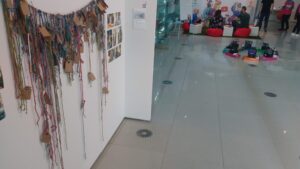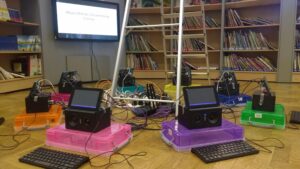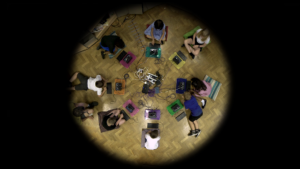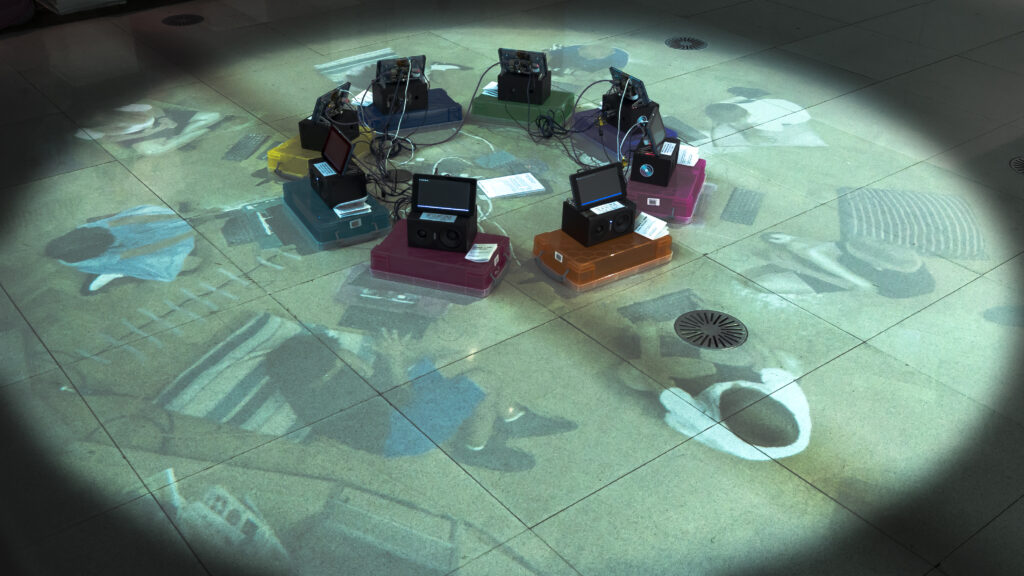 The residency at CMC Playground that I mentioned before is coming to an end, so time for a quick reflective blog post.
The residency at CMC Playground that I mentioned before is coming to an end, so time for a quick reflective blog post.
The idea was to work with schoolchildren to explore pattern encoding through textiles and live coding. It’s been a rollercoaster, getting a lot done in a short amount of time, but was really rewarding.
I worked with sixty Y4s (8-9 year olds) at Wybourn Community Primary, first making a big quipu-inspired structure, the tangly thing above. I had half a day with each class (30 in each), teaching them how to self-ply yarn to make quipu-like strands (with a loop one end for cow hitching), teaching them to tie numbers as quipu knots, and then having a free-for-all where they tried hiding messages in string, starting with their age and then moving on to hiding letters and so on. This bit was far more difficult than teaching them to do live coding later on, quite a few weren’t confident with knot-tying to begin with, but they all managed to produce something in the end, with a wide variety of structures… and once I’d hitched them all onto a main strand I think they looked marvellous.
 I also worked with the same year group on Algorithmic Drumming Circles, this time in groups of eight. I had just one hour with each group to introduce the concept of live coding, teach them enough Tidal to get them making music together, and capture a performance to be played back at the exhibition. The first couple of groups didn’t have parental permission for the filmed, so I had the opportunity to try some different things out. I had some playing cards prepared with fragments of code for the kids to put together and type in, but I decided not to use them after the first try. In fact, it seemed the more I constrained the task, the more creative the children would get. So in the end I only gave them two sounds each to play with (a high drum and
I also worked with the same year group on Algorithmic Drumming Circles, this time in groups of eight. I had just one hour with each group to introduce the concept of live coding, teach them enough Tidal to get them making music together, and capture a performance to be played back at the exhibition. The first couple of groups didn’t have parental permission for the filmed, so I had the opportunity to try some different things out. I had some playing cards prepared with fragments of code for the kids to put together and type in, but I decided not to use them after the first try. In fact, it seemed the more I constrained the task, the more creative the children would get. So in the end I only gave them two sounds each to play with (a high drum and  a low drum – each computer with subtly different drums/tones), told them how to make sequences, and some functions for transforming them with some higher-order stuff. They responded to this really well and we actually managed to capture two performances with two of the groups and still be done by end of the hour!
a low drum – each computer with subtly different drums/tones), told them how to make sequences, and some functions for transforming them with some higher-order stuff. They responded to this really well and we actually managed to capture two performances with two of the groups and still be done by end of the hour!
I say ‘we’, it was actually my friend Jon Harrison who did the filming. It was a challenge to capture the circle, Jon managed to get a nice camera attached to the ceiling to film from the top-down, the results are excellent.

On the technical side, I had eight Pis tightly synced together (using ptpd), each running Tidal, Dirt and my new feedforward editor. I had all the keyboard events captured with accurate timing so that the live coding could be perfectly recorded and played back in the or the exhibition itself, the computers were set up in the same way, but without keyboards, and had the film projected down onto the floor. It works well I think, seeing these ghostly children type, and thanks to some network magic, you can look at the screen and see what they’re typing, as well as hearing their music come from their speaker. You can really see where the children hear something they like that one of their friends is making, run round to look at the code, then run back and try out their newly learned technique. Free software at work. With a different rhythm coming from each speaker, all nicely locked to the same tempo, the result is pretty cosmic, eight-channel rhythmic free-for-all that somehow gels at several points into some really nice techno grooves, and at other times breaks up into noisy experimentalism. The kids clearly enjoyed themselves a lot. We captured five different performances in the end that the installation cycles between.
Although we did have parental permission to film the children, we’re still not going to put the films online, as the children themselves might well not want films of themselves on the internet as they get older. But you can still see the work in the Playground exhibition at the Millennium Gallery in Sheffield for a few more days. I might put the music up at some point but the eight-channel nature of it is a bit problematic.
I’m left with a familiar feeling from this kind of short, intense project – the memory of a strong, uncertain feeling at the start of the project when there is a vague idea that seems impossible, mixing with the fleeting elation of somehow having managed to pull it off. I’m looking forward to taking this further, probably working with adults next to see how they can compete…
Anyway it’s not over yet – the exhibition goes on, and tomorrow (Friday) I work with three older kids from a different school – Crofton Academy in Wakefield – for a live performance in the gallery from midday.. Then celebrating with an (adult) Algorave in the evening..
As a result of this project I’m actually much closer to finally releasing my long overdue Spicule album. I put a lot of work into the feedforward editor to make it usable and robust to 8 year olds, and a lot of Raspberry Pi optimisation to make it all sing. More on all that soon..
Anyway thanks to the kids + teachers (esp Julian and Jane) for getting involved, Jon for filming, Kathy and Darren and the rest of the CMC crew, plus Rosie + Laura from Millennium Gallery for all the support! Plus Arts Council England for funding the whole endeavor.